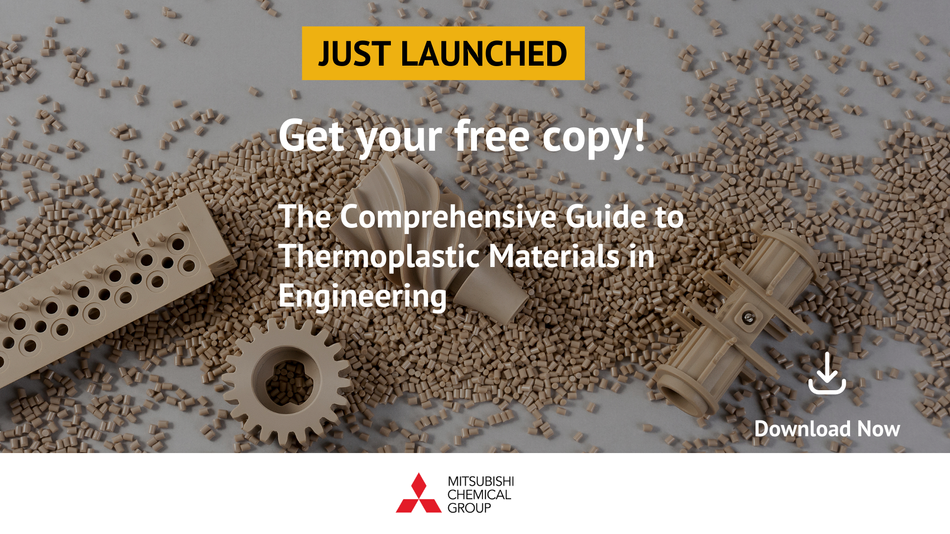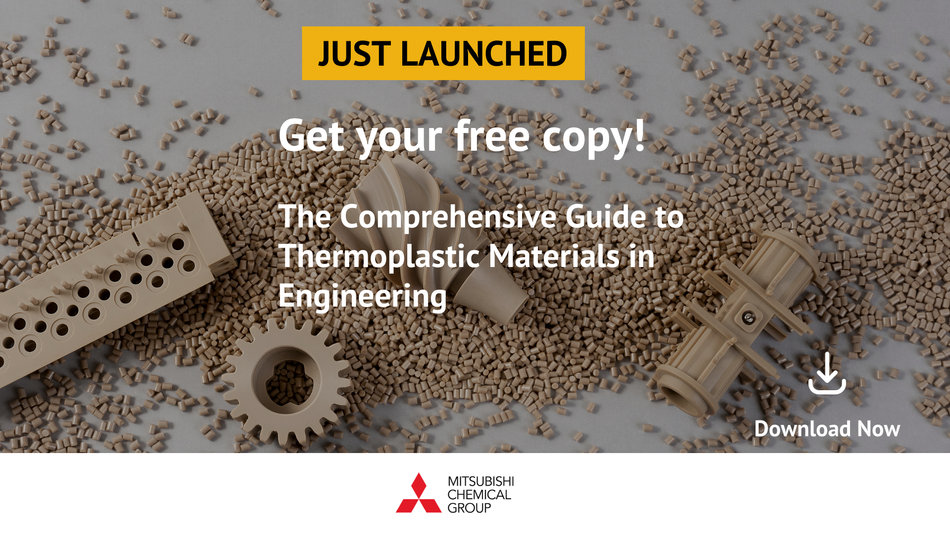Engineering Thermoplastics Guide. Chapter 2. Processing Techniques of Engineering Thermoplastics
This chapter excerpt discusses thermoplastic processing in engineering, highlighting challenges like precise parameter control and moisture sensitivity while emphasizing methods like injection molding, extrusion, and additive manufacturing for shaping thermoplastics to meet diverse needs.
This is an excerpt from Chapter 2 of The Engineering Thermoplastics Guide. Download the full guide below for the full text, including technical diagrams and application notes.

Introduction
The widespread success of thermoplastic materials today is related to their easy processability. Compared to thermosets, which undergo irreversible curing processes, thermoplastics can be reversibly melted and hardened in any desired shape. In the post-war era, the worldwide use of thermoplastics surpassed that of thermosets in most applications due to increased production, low cost, and ease of manufacturing.
While conventional techniques, including subtractive manufacturing (machining), welding, and gluing can be applied to most thermoplastics, melt-processing offers advantages unique to thermoplastic materials. In melt-processing, granules or powder of plastics are heated to reduce the viscosity to allow easy shaping of the desired components. Melt-processing offers design freedom at very low costs and is one of the core reasons for the widespread success of thermoplastic materials. [1]
In recent years, additive manufacturing has emerged as an increasingly powerful solution across various industries. Because of their characteristics, thermoplastics are the most suitable materials for 3D printing. However, developing additive manufacturing processes for engineering and advanced thermoplastics is still an open challenge.
The processability of thermoplastics depends on the specific properties of each material. While for most commodity plastics the manufacturing is straightforward, in the case of engineering and advanced thermoplastics there are unique challenges to keep in mind. Material waste needs to be minimized, and consistent quality and performance must be ensured for demanding engineering applications.
In this chapter except you will learn about the most significant challenges in engineering thermoplastic processing. The main processing methods of thermoplastics and their applications will be discussed. Download the full report for images, graphs and case studies.
Challenges of Processing Engineering Thermoplastics
Thermoplastics offer several advantages, including easy processing with low energy consumption, low density, and aesthetic appeal. However, achieving quality plastic products can be challenging, especially when high-performance standards are required. To address this, a careful design process is crucial, starting with the selection of the most suitable processing method for your thermoplastic of choice.
Manufacturing thermoplastic components demands precise control of temperature, pressure, and cooling rates due to narrow processing windows, which, if not followed, can lead to defects and product failure. Melt processing can lead to anisotropy in the finished products, resulting in directionally dependent physical properties in the material., Thiswhich can determineresult in inconsistent mechanical properties in the final component. When substituting metal with engineering or advanced thermoplastics, you should keep in mind that different materials pose unique design challenges.
Many engineering and advanced thermoplastics, such as PC, PEI, and PA, are moisture-sensitive, necessitating careful drying prior to melt-processing to prevent material degradation and maintain product performance. Moisture can adversely affect the plastics' properties leading to bubbles, imperfections, or reduced mechanical properties.
Additionally, advanced thermoplastics require exceptionally high processing temperatures, often surpassing 300 °C. This requires specialized heating elements, insulation, and cooling procedures. High energy expenditure and increased safety precautions should also be considered. [5]
Injection molding is a melt-processing approach where thermoplastic material is heated and subjected to pressure, filling the interior of a mold. Afterward, the thermoplastics cool and regain rigidity, completing the molding cycle. After demolding the cycle can start from new. An injection-molding machine consists of an extruder for plasticizing the resin, a ram system for high-pressure material introduction into the mold, and a cooling device to facilitate part solidification. Key variables in the injection molding process include cylinder temperature, mold temperature, injection rate, holding pressure, back pressure, and the speed of the screw's rotation.[6]
One of the key challenges of injection molding is that, due to differences in densities between the solid polymer and the melt, cooling results in dimensional shrinkage. In the case of some semi-crystalline polymers, this contraction can reach 20% of the original volume.
The inherent shrinkage can be compensated for by injecting additional material in a step known as the holding phase. However, a residual contraction between 0.5% and 2.5% is unavoidable with injection molding, and should always be kept into account when designing the molds.[1]
Additive Manufacturing of Engineering Thermoplastics
Additive manufacturing of thermoplastics, also known as 3D printing, offers an alternative approach to creating complex parts rapidly, layer by layer, without the need for traditional tool and mold fabrication and with maximum design freedom. This technology has revolutionized the production of prototypes and products, resulting in substantial cost and time savings since its invention in 1986.
Due to their ability to melt and solidify into any desired shape, thermoplastics are the ideal materials for additive manufacturing and have been the first materials used for this technology. Among the different 3D printing processes utilized today for thermoplastics, most can be classified into two categories.
1. Extrusion 3D printing (E3DP). In E3DP, the material is heated to reduce its viscosity and extruded through the printer’s nozzle. For small-scale printers, the preferred approach is fused filament fabrication or FFF. Small-scale FFF printers extrude thermoplastic polymer filaments through a heated nozzle onto a heated bed, allowing for fast and cost-effective component production. However, these printers have limitations, including filament diameter constraints and smaller print areas. To address these challenges, large-scale extrusion printers for Big Area Additive Manufacturing or BAAM have been developed. These technologies implement more efficient feed systems and allow for faster production rates.
2. Powder Bed Fusion (PBF). In PBF, the powdered material is locally melted with a high-energy laser beam. Subsequent deposition and fusion of powder layers result in the gradual formation of the finished product. This process is suitable for large-scale industrial printing and can be used with engineering and advanced thermoplastics with higher melting temperatures.
For FFF, commodity plastics such as PETG and HDPE are a common choice. However, also engineering plastics such as polyamides and polycarbonates can be used with most professional extrusion 3D printers.
The technology for 3D printing with advanced thermoplastics is still in its infancy. Materials such as PEEK and PEI are challenging to extrude but can be used with PBF technology. New thermoplastic blends, composed of a mixture of advanced and standard thermoplastics, are also emerging as a suitable choice for additive manufacturing. [8]
Selecting the Right Processing Method
The choice of processing method for thermoplastics depends on the specific requirements of the desired application. Injection molding stands out as an excellent choice for mass production of standard thermoplastics due to its automation capabilities, cost efficiency, and superior surface finish. However, challenges such as part warpage and shrinkage should be carefully considered.
Extrusion processes are ideal for producing parts with constant cross-sections, making them suitable for products like pipes and window profiles. While versatile and capable of high output, they have limitations when it comes to incorporating reinforcements and can result in anisotropic properties.
Compression molding is particularly well-suited for engineering and advanced thermoplastics with high melting temperatures, offering advantages like minimal material waste and the ability to maintain product performance. This method is especially valuable for producing high-performance engineering components.
Additionally, additive manufacturing, or 3D printing, has revolutionized rapid prototyping and product development. It is a valuable option for complex, customized parts, with extrusion 3D printing (E3DP) suitable for small-scale applications and Powder Bed Fusion (PBF) better suited for large-scale industrial printing, especially with engineering and advanced thermoplastics like PEEK and PEI.
Ultimately, the selection of the most suitable processing method should be based on factors such as material properties, production volume, design complexity, and cost considerations, ensuring that the chosen method aligns with the specific needs of each application.
You have just been reading an excerpt from Chapter 2 of The Engineering Thermoplastics Guide. Download the full guide below for the full text, including technical diagrams and application notes.


